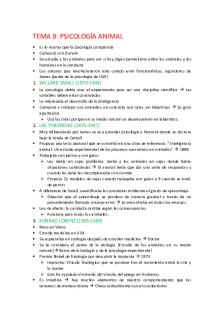Animal Biology PDF

| Title | Animal Biology |
|---|---|
| Course | Biology II |
| Institution | Laurentian University |
| Pages | 2 |
| File Size | 52.8 KB |
| File Type | |
| Total Downloads | 77 |
| Total Views | 164 |
Summary
Animal Bo...
Description
Animal Biology Animal Kingdom Chapter 27, page 543 General -
-
-
Animals are multicellular, heterotrophic, eukaryotes. Animals must take into their body perform organic molecules and this is done by ingestion Animal cells lack cell wall, no as the case in plants and fungi The multicellular bodies of animals are held together by the structural protein and the most abundant being Collagen Also unique among animals are two types of tissues which are responsible for impulse conduction and movement: the nervous tissue and muscle tissue Most animals reproduce sexually, with the diploid stage usually dominating life cycle In most species, a small flagellated sperm fertilizes a larger non-motile egger to form a zygote The zygote undergoes cleavage, a succession of mitotic cell division, during the development of most animals, cleavage will lead to the formation of a mulitcellular stage called a blastula, in which in most animals take the form of a hollow ball, following the blastula stage is the process of gastrulation, during which layers of embryonic tissues that will develop into adult body are produced. The resulting stage is called a gastrula However the life cycle of many animals include larval stage The larva is sexually immature form, it is morphologically distinct from the adult stage and may even have a different habitat than the adult and also usually eat different food than the adult, for example n the case of a frog and tadpole Animas larvae usually undergoes metamorphoses that will transform the animal to an adult
Major Branches of the Animal Kingdom -
-
Most zoologists agree that the animal kingdom has two separate origins from Protoctistan ancestors o Sub kingdom: Parazoa (means beside the animals) Sponges, are set apart by their anatomical simplicity from all animal phylum (phylum porifera) o Sub kingdom: Eumetozoa Details of embryonic development and other evidence tend to support a theory of independent origin from sponges The Eumetozoa have been divided into two major branches based on body symmetry o Radiata: for example consists of Jelly fish and their relations. A radial animal has a top and bottom, an oral and aboral side, but not front or back and not left and right
-
o Bilateria Animal with bilateral symmetry, the animal has not only a top and bottom but also a head (anterior) and tail (posterior) and a left and right side. Associated with bilateral symmetry in cephalisation, an evolutionary trend toward concentration of sensory equipment on the anterior end, the end of travelling animal tjhat os uisaully forint to enoucr fiumd...
Similar Free PDFs

Animal Biology
- 2 Pages

Biology Animal and Plant Cells
- 2 Pages

Tiend Animal
- 4 Pages

Desarrollo animal
- 6 Pages

Animal Reproduction
- 122 Pages

Arquitectura animal
- 5 Pages

Histologia animal
- 2 Pages

Psicología animal
- 1 Pages

The Social Animal
- 312 Pages

Animal experimentation essay
- 6 Pages

Casisirer - El animal simbòlico
- 7 Pages

ANimal farm esssay .docx
- 5 Pages
Popular Institutions
- Tinajero National High School - Annex
- Politeknik Caltex Riau
- Yokohama City University
- SGT University
- University of Al-Qadisiyah
- Divine Word College of Vigan
- Techniek College Rotterdam
- Universidade de Santiago
- Universiti Teknologi MARA Cawangan Johor Kampus Pasir Gudang
- Poltekkes Kemenkes Yogyakarta
- Baguio City National High School
- Colegio san marcos
- preparatoria uno
- Centro de Bachillerato Tecnológico Industrial y de Servicios No. 107
- Dalian Maritime University
- Quang Trung Secondary School
- Colegio Tecnológico en Informática
- Corporación Regional de Educación Superior
- Grupo CEDVA
- Dar Al Uloom University
- Centro de Estudios Preuniversitarios de la Universidad Nacional de Ingeniería
- 上智大学
- Aakash International School, Nuna Majara
- San Felipe Neri Catholic School
- Kang Chiao International School - New Taipei City
- Misamis Occidental National High School
- Institución Educativa Escuela Normal Juan Ladrilleros
- Kolehiyo ng Pantukan
- Batanes State College
- Instituto Continental
- Sekolah Menengah Kejuruan Kesehatan Kaltara (Tarakan)
- Colegio de La Inmaculada Concepcion - Cebu



